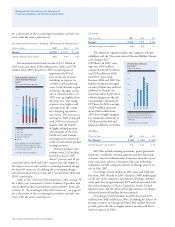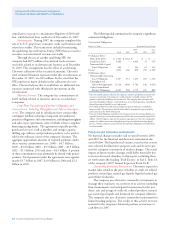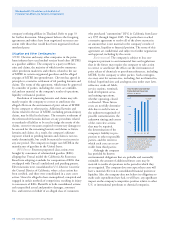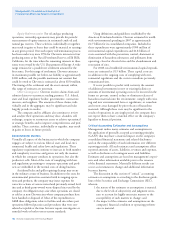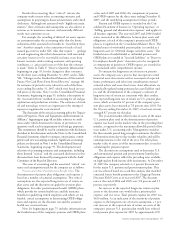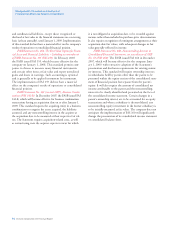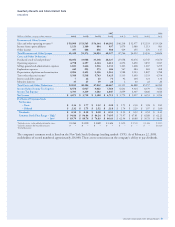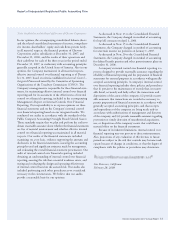Chevron 2007 Annual Report Download - page 47
Download and view the complete annual report
Please find page 47 of the 2007 Chevron annual report below. You can navigate through the pages in the report by either clicking on the pages listed below, or by using the keyword search tool below to find specific information within the annual report.
45
The following table displays the annual changes to the
company’s before-tax environmental remediation reserves,
including those for federal Superfund sites and analogous sites
under state laws.
Millions of dollars 2007 2006 2005
Balance at January 1 $ 1,441 $ 1,469 $ 1,047
Net Additions 562 366 731
Expenditures (464) (394) (309)
Balance at December 31 $ 1,539 $ 1,441 $ 1,469
Included in the $1,539 million year-end 2007 reserve
balance were remediation activities of 240 sites for which
the company had been identified as a potentially responsible
party or otherwise involved in the remediation by the U.S.
Environmental Protection Agency (EPA) or other regulatory
agencies under the provisions of the federal Superfund law or
analogous state laws. The company’s remediation reserve for
these sites at year-end 2007 was $123 million. The federal
Superfund law and analogous state laws provide for joint
and several liability for all responsible parties. Any future
actions by the EPA or other regulatory agencies to require
Chevron to assume other potentially responsible parties’ costs
at designated hazardous waste sites are not expected to have a
material effect on the company’s consolidated financial posi-
tion or liquidity.
Of the remaining year-end 2007 environmental reserves
balance of $1,416 million, $864 million related to approxi-
mately 2,000 sites for the company’s U.S. downstream
operations, including refineries and other plants, marketing
locations (i.e., service stations and terminals) and pipelines.
The remaining $552 million was associated with various sites
in international downstream ($146 million), upstream ($267
million), chemicals ($105 million) and other ($34 million).
Liabilities at all sites, whether operating, closed or divested,
were primarily associated with the company’s plans and
activities to remediate soil or groundwater contamination or
both. These and other activities include one or more of the
following: site assessment; soil excavation; offsite disposal
of contaminants; onsite containment, remediation and/or
extraction of petroleum hydrocarbon liquid and vapor from
soil; groundwater extraction and treatment; and monitoring
of the natural attenuation of the contaminants.
The company manages environmental liabilities under
specific sets of regulatory requirements, which in the United
States include the Resource Conservation and Recovery
Act and various state or local regulations. No single remedi-
ation site at year-end 2007 had a recorded liability that
was material to the company’s financial position, results of
operations or liquidity.
It is likely that the company will continue to incur
additional liabilities, beyond those recorded, for environ-
mental remediation relating to past operations. These
future costs are not fully determinable due to such factors
as the unknown magnitude of possible contamination, the
unknown timing and extent of the corrective actions that
may be required, the determination of the company’s liability
in proportion to other responsible parties, and the extent to
which such costs are recoverable from third parties.
The company accounts for asset retirement obligations
in accordance with Financial Accounting Standards Board
Statement (FASB) No. 143, Accounting for Asset Retirement
Obligations (FAS 143). Under FAS 143, the fair value of a
liability for an asset retirement obligation is recorded when
there is a legal obligation associated with the retirement of
long-lived assets and the liability can be reasonably esti-
mated. The liability balance of approximately $8.3 billion
for asset retirement obligations at year-end 2007 related pri-
marily to upstream and mining properties.
For the company’s other ongoing operating assets, such as
refineries and chemicals facilities, no provisions are made for
exit or cleanup costs that may be required when such assets
reach the end of their useful lives unless a decision to sell or
otherwise abandon the facility has been made, as the inde-
terminate settlement dates for the asset retirements prevent
estimation of the fair value of the asset retirement obligation.
Refer also to Note 23, beginning on page 84, related
to FAS 143 and the company’s adoption in 2005 of FASB
Interpretation No. (FIN) 47, Accounting for Conditional Asset
Retirement Obligations – An Interpretation of FASB Statement
No. 143 (FIN 47), and the discussion of “Environmental
Matters” on page 46.
Income Taxes The company calculates its income tax
expense and liabilities quarterly. These liabilities generally are
subject to audit and are not finalized with the individual tax-
ing authorities until several years after the end of the annual
period for which income taxes have been calculated. Refer to
Note 15 beginning on page 70 for a discussion of the periods
for which tax returns have been audited for the company’s
major tax jurisdictions and a discussion for all tax jurisdic-
tions of the differences between the amount of tax benefits
recognized in the financial statements and the amount taken
or expected to be taken in a tax return. The company does
not expect settlement of income tax liabilities associated with
uncertain tax positions will have a material effect on its
results of operations, consolidated financial position or
liquidity.
Suspended Wells The company suspends the costs of
exploratory wells pending a final determination of the com-
mercial potential of the related crude oil and natural gas
fields. The ultimate disposition of these well costs is depend-
ent on the results of future drilling activity or development
decisions or both. At December 31, 2007, the company had
approximately $1.7 billion of suspended exploratory wells
included in properties, plant and equipment, an increase of
$421 million from 2006 and an increase of $551 million
from 2005.
The future trend of the company’s exploration expenses
can be affected by amounts associated with well write-offs,
including wells that had been previously suspended pend-
ing determination as to whether the well had found reserves
that could be classified as proved. The effect on exploration
expenses in future periods of the $1.7 billion of suspended
wells at year-end 2007 is uncertain pending future activities,
including normal project evaluation and additional drilling.
Refer to Note 19, beginning on page 74, for additional
discussion of suspended wells.



